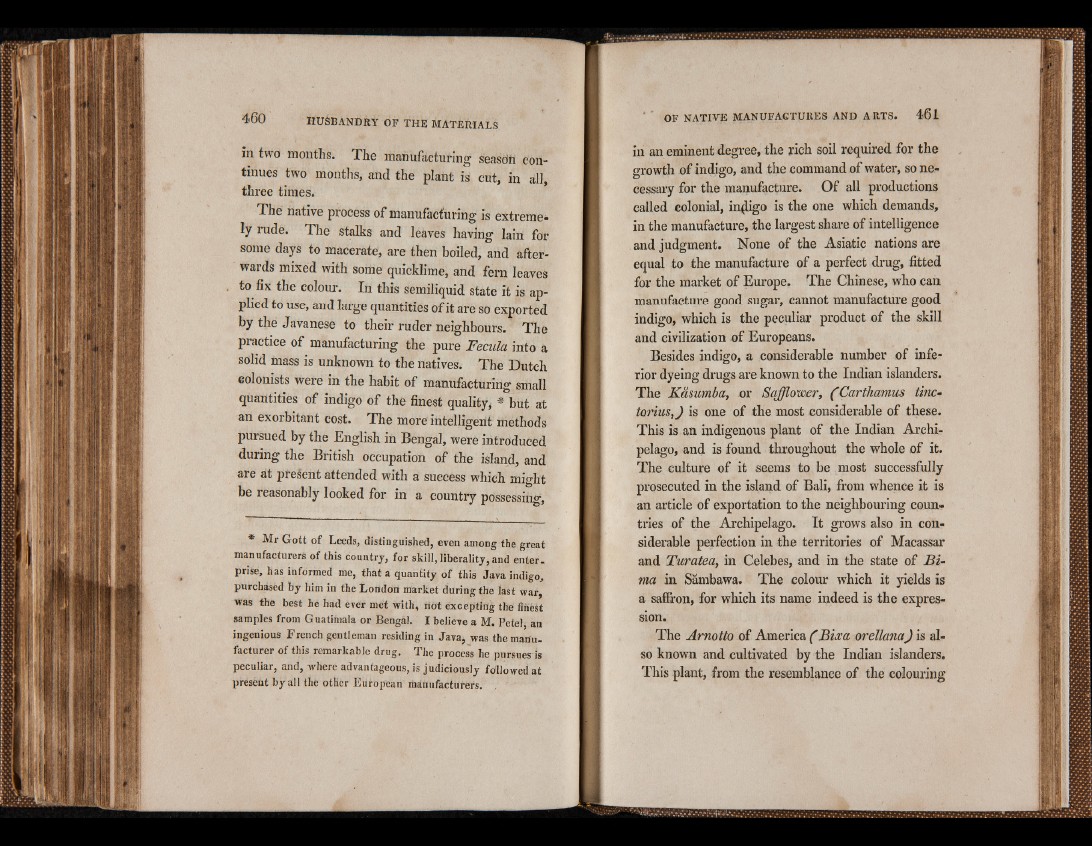
in two months. The manufacturing seasdn continues
two months, and the plant is cut, in all,
three times.
The native process of manufacturing is extremely
rude. The stalks and leaves having lain for
some days to macerate, are then boiled, and afterwards
mixed with some quicklime, and fern leaves
to fix the colour. In this semiliquid state it is applied
to use, and large quantities of it are so exported
by the Javanese to their ruder neighbours. The
practice of manufacturing the pure Fecula into a
solid mass is unknown to the natives. The Dutch
colonists were in the habit of manufacturing small
quantities of indigo of the finest quality^ but at
an exorbitant cost. The more intelligent methods
pursued by the English in Bengal, were introduced
during the British occupation of the island, and
are at present attended with a success which might
be reasonably looked for in a country possessing,
* Mr Gott of Leeds, distinguished, even among the great
manufacturers of this country, for skill, liberality, and enter,
prise, has informed me, that a quantity of this Java indigo,
purchased by him in the London market during the last war,
was the best he had ever met with, not excepting the finest
samples from Guatimala or Bengal. I believe a M. Petel, an
ingenious French gentleman residing in Java, was the manufacturer
of this remarkable drug. The process he pursues is
peculiar, and, where advantageous, is judiciously followed at
present by all the other European manufacturers.
in an eminent degree, the rich soil required for the
growth of indigo, and the command of water, so necessary
for the manufacture. Of all productions
called colonial, indigo is the one which demands,
in the manufacture, the largest share of intelligence
and judgment. None of the Asiatic nations are
equal to the manufacture of a perfect drug, fitted
for the market of Europe. The Chinese, who can
manufacture good sugar, cannot manufacture good
indigo, which is the peculiar product of the skill
and civilization of Europeans.
Besides indigo, a considerable number of inferior
dyeing drugs are known to the Indian islanders.
The Kasumba, or Safflower, ( Carthamus tine-
tarius,J is one of the most considerable of these.
This is an indigenous plant of the Indian Archipelago,
and is found throughout the whole of it.
The culture of it seems to be most successfully
prosecuted in the island of Bali, from whence it is
an article of exportation to the neighbouring countries
of the Archipelago. It grows also in considerable
perfection in the territories of Macassar
and Turatea, in Celebes, and in the state of F ima
in Sambawa. The colour which it yields is
a saffron, for which its name indeed is the expression.
The Arnotto of America ( Bixa orellana) is also
known and cultivated by the Indian islanders.
This plant, from the resemblance of the colouring